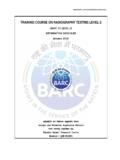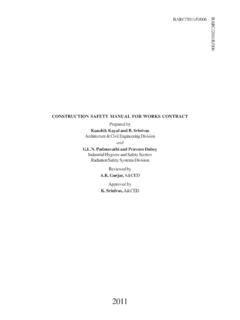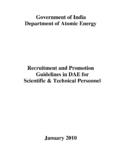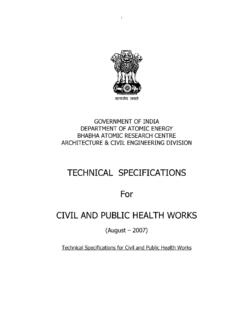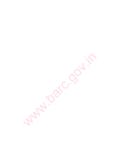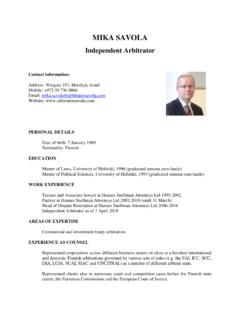Transcription of Design & Development of Facility for Production of Active ...
1 Technology Deveploment Article56 | november -DECEMBER 2015 BARC NEWSLETTERD esign & Development of Facility for Production of Active Cs-137 Source Pencils for blood irradiator Satish B. Patil, Jyoti Jha, Puneet Srivastava, Shakti Mishra, Rituparna Datta and Siddhartha S. KhanTechnology Development DivisionIntroductionIn India Co-60 is the isotope presently being used for medical applications. It needs frequent replacement because of its short half life ( Years) resulting in multiple handling, transportation and loading-unloading operations. Further, in Indian scenario, Production of Co-60 also leads to reactivity losses and in turn revenue losses to the nuclear power reactors.
2 However, Cs-137, the major constituent of the nuclear waste, is a suitable substitute for Co-60 as a radioactive source because of its longer half life (30 yrs). Nuclear Recycle Group has given special emphasis on utilization of Cs-137 for such applications. This will give societal benefits in addition to the revenue generation and will also address issues related to disposal aspects of High Level Radioactive traditionally Cs as Cesium Chloride (CsCl) powder has been used in radiation source applications elsewhere in the world, CsCl is highly soluble in water and the powder can get easily dispersed resulting in release of activity under accidental conditions.
3 It is thus desirable to use Cs in immobilized form, with good product characteristics, so that high degree of safety can be ensured during its use in public domain. Historical BackgroundIn accordance with the Policy of Closed Fuel Cycle, India had developed an expertise in vitrification of High Level Nuclear Waste (HLW) and industrial scale vitrification plants have been set up at WIP-Tarapur, WIP-Trombay and AVS-Tarapur for vitrification of the HLW. Further, during refinement of Indian Waste Management Policy, emphasis was given on separation of actinides and high yield radio-nuclides like Cs-137 from the nuclear waste.
4 Ion Exchange & Solvent Extraction Processes had been indigenously developed for separation of Cs-137. Separation of Cs-137, major heat generating radionuclide in HLW, will be advantageous in terms of reduced radio-toxicity of the remaining waste and reduced heat load during long term storage of such waste. In-spite of having expertise in vitrification of nuclear waste, the main hurdle in manufacturing of Cs-137 source pencils was the controlled pouring of the vitirified glass in stainless steel efforts for making Cs-137 source pencils were based on the concept of preparation of small spherical beads and putting them inside the stainless steel pencils.
5 However, difficulty in making uniform beads due to corrosive nature of the vitrified product and presence of voids inside the source pencil , the bead making concept was not pursued further. Subsequently, it was decided to make the Cs source pencils based on the concept of direct controlled pouring of accurately measured vitrified product into stainless steel pencils. Abstract:The search for an option for a radioactive source, alternative to Co-60, is on for quite some time. Abundance of Cs-137, a high yield radionuclide, in the nuclear waste has prompted the idea of separation of the same from the nuclear waste and making it suitable for medical and industrial applications.
6 This will give the societal benefits in addition to revenue generation. Longer half life of Cs-137 (30 Yrs) is an added advantage of using this isotope over Co-60. Hence, as a special emphasis in Indian Nuclear Waste Management programme, a Facility has been designed, installed and commissioned for Production of Cs-137 source pencils in vitrified form to be used as source pencils for blood Deveploment ArticleNOVEMBER-DECEMBER 2015 | 57 BARC NEWSLETTERE volution of Glass Pouring TechnologyThe simplified block diagram of the activities involved in Production of Cs-137 source pencils is shown in Fig. 1. Among all, the controlled pouring of vitrified product into the pencils is one of the most important activities.
7 Mainly three Design approaches were attempted progressively for controlled pouring of the vitrified product into the pencils as shown in Fig. 2:a) Glass Bead MethodInitial concept of making Cs Source pencils was based on the preparation of 1-2 mm dia. glass beads to be filled into the pencils. The nozzles having 1 mm and mm diameter opening were used for making the beads as shown in Fig. 2(a). However, it was observed that the method was not a practical solution because of the following:i) Very high temperature requirement at the tip of nozzle to initiate the glass ) After few cycles of operation, the nozzle bore was getting enlarged due to the glass ) Freeze Valve MethodIn this method, the vitrified mass is poured by energizing the bottom freeze plug directly into the source pencils ref.
8 (b), a process similar to being followed at WIP. Multiple trials were carried out with different sets of temperature cycles. However, it was found to be very difficult to achieve the control over the glass viscosity and quantity being poured. Moreover, glass thread formation, which was not acceptable, and difficulty in predicting the start and end points of glass pouring were the shortcomings of this method. c) Mechanical Plug MethodIn order to achieve a fine control on pouring, the process pot Design was modified with provision of a mechanical plug and seat type arrangement. Subsequently, the Design was fine tuned through progressive modification of the plug and the seat (refer c, d and e).
9 In this Design , the plug was actuated through a pneumatic actuator to start / stop the pouring of vitrified product into the pencils placed on Product Trolley. This Design has resulted in the most successful option among all the approaches tried for controlled pouring with which the pencils can be filled appropriately without any spillage of the vitrified product. Applications & Advantages of Cs-137Cs-137 Source Pencils will have following applications: blood Irradiation. Food Irradiation. Brachytherapy. Sterlization of Medical present, BARC has targeted the Development of Cs-137 Source pencils for blood Irradiation application only. Advantages of Cs-137 as Radioactive Source over Co-60 Sources are:Fig.
10 1: Block Diagram of the FaciltyFig. 2: Progressive Designs of Process PotTechnology Deveploment Article58 | november -DECEMBER 2015 BARC newsletter Reduced frequency of Source replenishment. Less handling and transportation. Less shielding requirement. Ready availability in nuclear waste. Reduction in radio-toxicity of remaining HLW. Reduction in heat load of remaining HLW, thereby resulting in reduced or no cooling requirements. Present FacilityTechnology Development Division (TDD) has rigorously worked on the critical aspects like Design of mechanical plug based induction heated furnace which will ensure the controlled pouring of vitrified product at a temperature of around 9500 C in SS pencils of 23 mm OD and 204 mm in length.

